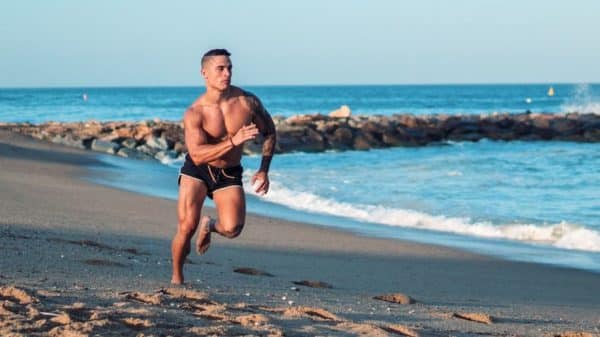Chaque jour, sans que vous ne le sachiez, votre corps a recours à la proprioception pour se mouvoir dans l’espace. C’est encore plus vrai si vous faites de l’activité physique, que ce soit de la musculation, de la course à pied, de la natation ou n’importe quelle autre discipline. Le simple fait de la travailler par le biais d’exercices de proprioception adaptés peut vous aider à améliorer vos performances.
Pour cela, il convient de solliciter différentes articulations telles que les chevilles ou les genoux. Découvrez comment dans ce guide complet.
Les exercices de proprioception, en bref :
- La proprioception permet au corps de se situer et de se déplacer dans l’espace.
- Elle joue un rôle clé dans la vie quotidienne et dans les performances sportives.
- Travailler la proprioception améliore l’équilibre, la coordination et le renforcement musculaire.
- Les exercices proprioceptifs aident à prévenir les blessures articulaires et ligamentaires.
- Il est possible de s’entraîner sans matériel ou avec des équipements comme un BOSU ou un swiss ball.
Sommaire
Qu’est-ce que la proprioception ?
La proprioception est souvent qualifiée de 6ème sens. Et c’est tout sauf un hasard.
Elle joue un rôle essentiel, aussi bien dans votre vie quotidienne que dans votre pratique sportive.
La proprioception désigne la capacité du corps humain à se situer et à se déplacer dans son espace. En d’autres termes, c’est la perception de soi-même. 🧠💡
En lisant cet article, vous savez inconsciemment, sans même regarder, où sont situées vos jambes. C’est grâce à la proprioception ! Et lorsque vous faites de la randonnée sur un terrain accidenté, c’est aussi grâce à la proprioception que vous gardez l’équilibre ou que vous ne vous foulez pas la cheville à chaque trou.
Physiologiquement, un tel phénomène est rendu possible par une compétence très précise du système nerveux. Ce dernier est capable de recevoir et de traiter une multitude d’informations fournies par les os, les muscles et les articulations.
Ce concept a été introduit par Charles Sherrington (prix Nobel de physiologie en 1932) au début du XXe siècle. 📚
Quel est le but du travail proprioceptif ?
Les exercices proprioceptifs permettent de solidifier les articulations des membres inférieurs (chevilles et genoux), mais aussi du haut du corps (notamment des épaules). Ils visent aussi à renforcer les muscles stabilisateurs situés autour de ces articulations, ainsi que la sangle abdominale.
Ainsi, lorsque vous faites un exercice de proprioception, vous gagnez en équilibre, en coordination et en force, tout en optimisant votre renforcement musculaire. Bref, vous améliorez votre condition physique. 🏋️♂️
Mais l’avantage principal de la proprioception, c’est qu’elle permet d’éviter les blessures articulaires et ligamentaires, principalement les entorses des chevilles et des genoux.1
Pour les sportifs ayant l’habitude de se blesser, mettre en place un programme d’entraînement proprioceptif est aussi un excellent moyen de limiter le risque de récidive.2
Enfin, faire de la proprioception régulièrement diminue le risque de blessure au niveau des lombaires.3
Faut-il du matériel pour faire un exercice de proprioception ?
Il est possible de faire des exercices de proprioception sans matériel et au poids du corps pour les débutants.
Toutefois, après quelques semaines ou mois d’entraînement, vous aurez certainement besoin de matériel spécifique pour accroître l’instabilité.
Rassurez-vous, la plupart des salles de sport possèdent ce type de matériel.
Voici quelques équipements dont vous pouvez avoir besoin pour vos entraînements de proprioception :
- Un BOSU (dont les 2 faces permettent de s’exercer)
- Un ballon de gym (ou swiss ball)
- Une planche d’équilibre
- Un coussin d’équilibre
- Un médecine ball, des disques de poids ou des haltères pour rajouter du lest
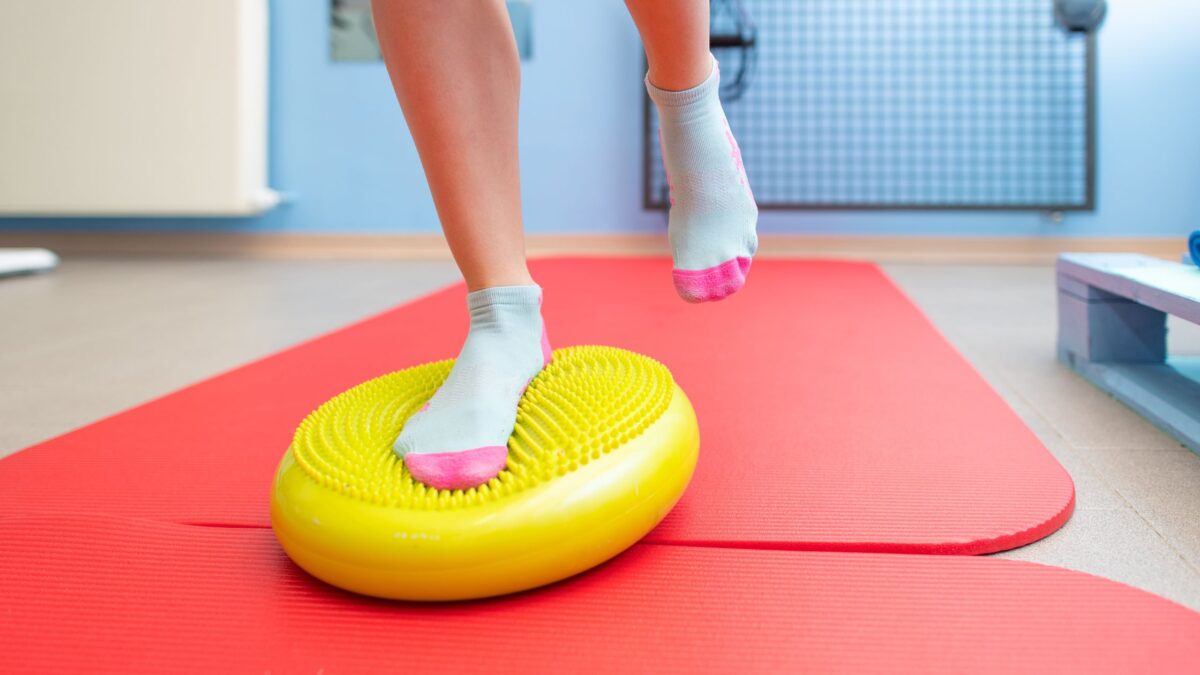
À la maison, vous pouvez faire quelques exercices en utilisant un cousin basique, dont la surface molle crée un début d’instabilité.
Enfin, avec ou sans matériel, sachez que vous pouvez complexifier chaque exercice de proprioception en fermant simplement les yeux. 😉
8 exercices de proprioception pour progresser
Plusieurs mouvements simples, accessibles aux sportifs débutants, peuvent vous aider à améliorer votre proprioception.

ENVIE D’UN PHYSIQUE ULTRA SEC ET VOLUMINEUX ?
Que vous fassiez un exercice de proprioception pour la cheville, pour le genou ou pour l’épaule, pensez à toujours évoluer de manière progressive. 📈
Exercices pour le bas du corps
Exercice 1 :
Ce mouvement est un exercice de proprioception de base. 🧘♂️
L’objectif est de maintenir une position statique durant plusieurs secondes en tenant en équilibre sur une jambe.
Ancrez vos deux pieds dans le sol, puis levez une jambe en contractant la ceinture abdominale. Inclinez légèrement votre jambe d’appui.
Vous pouvez rendre l’exercice plus difficile en le faisant sur un support instable (BOSU, coussin d’équilibre, etc.), puis en fermant les yeux. Commencez par la jambe gauche, puis passez à la droite.
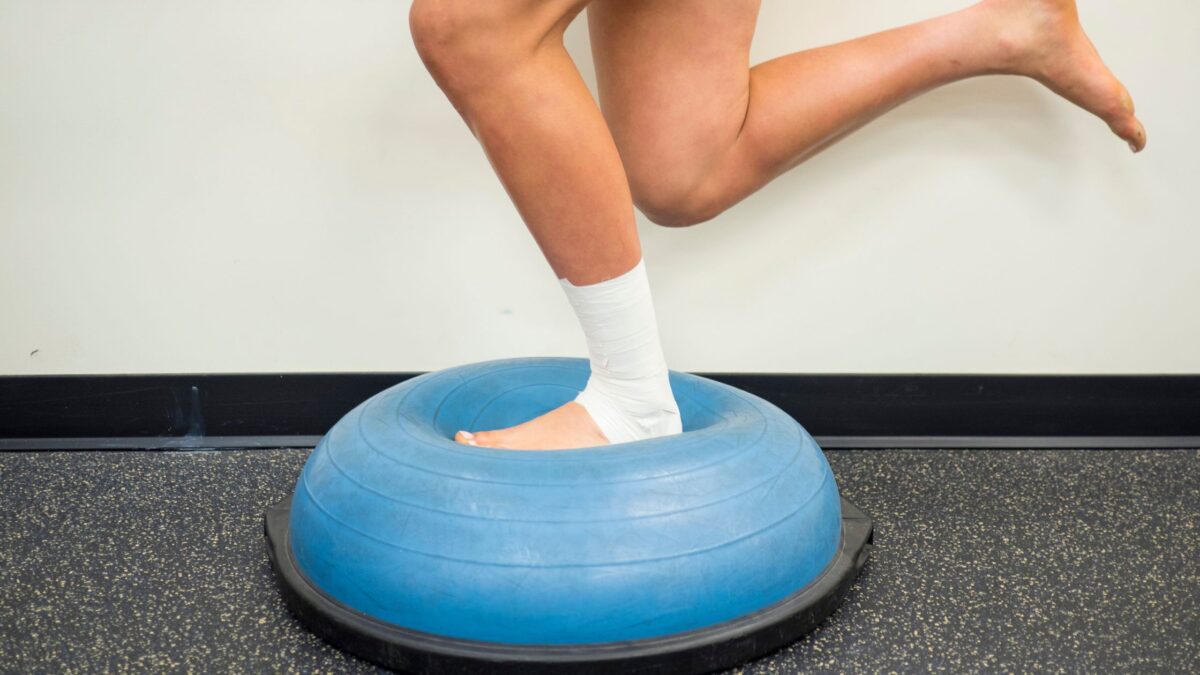
Exercice 2 :
Reprenez la position de départ de l’exercice 1.
Pour accroître l’instabilité et le travail des muscles sollicités, vous allez cette fois faire des mouvements.
Le premier mouvement consiste à effectuer des battements de bras, d’abord vers l’avant, ensuite vers l’arrière. Commencez lentement, et accélérez progressivement la vitesse à laquelle vous faites les cercles.
Pour le deuxième mouvement, inclinez votre buste vers l’avant, puis vers les côtés.
Exercice 3 :
Reprenez de nouveau la position initiale de l’exercice 1. Placez-vous cette fois face à un mur.
En appui sur l’une de vos deux jambes, le but est de lancer une balle contre le mur et de la rattraper à plusieurs reprises.
Exercice 4 :
Vous aurez besoin d’un support instable pour ce mouvement. La face rigide d’un BOSU est l’accessoire idéal.
Le principe est simple : réaliser des squats au poids du corps tout en gardant l’équilibre. Faites 4 à 5 séries d’une quinzaine de répétitions.
Cet exercice permet à la fois de renforcer les articulations et de muscler les cuisses. Il peut même servir d’échauffement avant votre leg day. 🔥
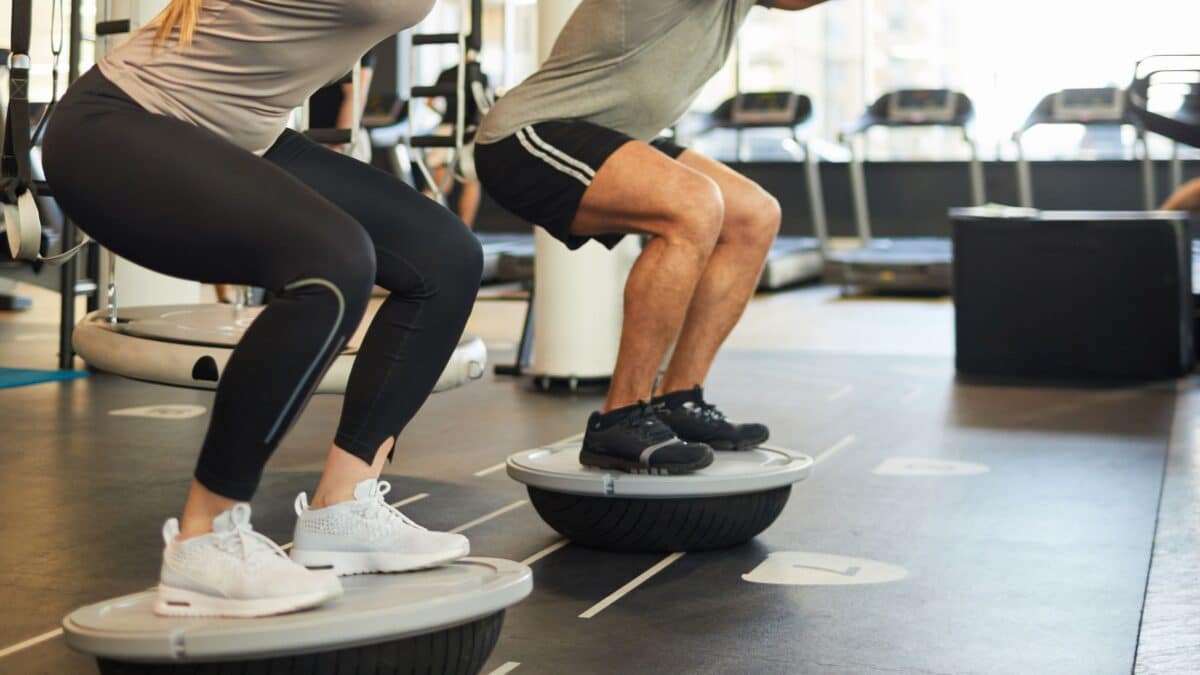
Exercice 5 :
Ce mouvement est un exercice de proprioception dynamique.
En sautant à cloche-pied, vous devez représenter une croix sur le sol en allant vers l’avant, vers l’arrière, vers la droite et vers la gauche. N’hésitez pas à varier l’ordre, la longueur et la vitesse des sauts.
Exercices pour le haut du corps
Exercice 1 :
Les exercices d’équilibre et proprioception peuvent aussi être intéressants pour renforcer vos épaules.
Ici, il vous suffit de mettre un ballon de fitness contre un mur, à hauteur de torse. En position debout, placez-vous en appui sur le ballon avec vos avant-bras (vos bras sont alors pliés) ou vos mains (vos bras sont alors tendus).
Restez dans cette position et repoussant le swiss ball contre le mur.
Exercice 2 :
Mettez-vous en position de planche, bras tendus, et tenez durant plusieurs secondes selon votre niveau. Ce simple exercice de gainage est excellent pour la proprioception de l’épaule.
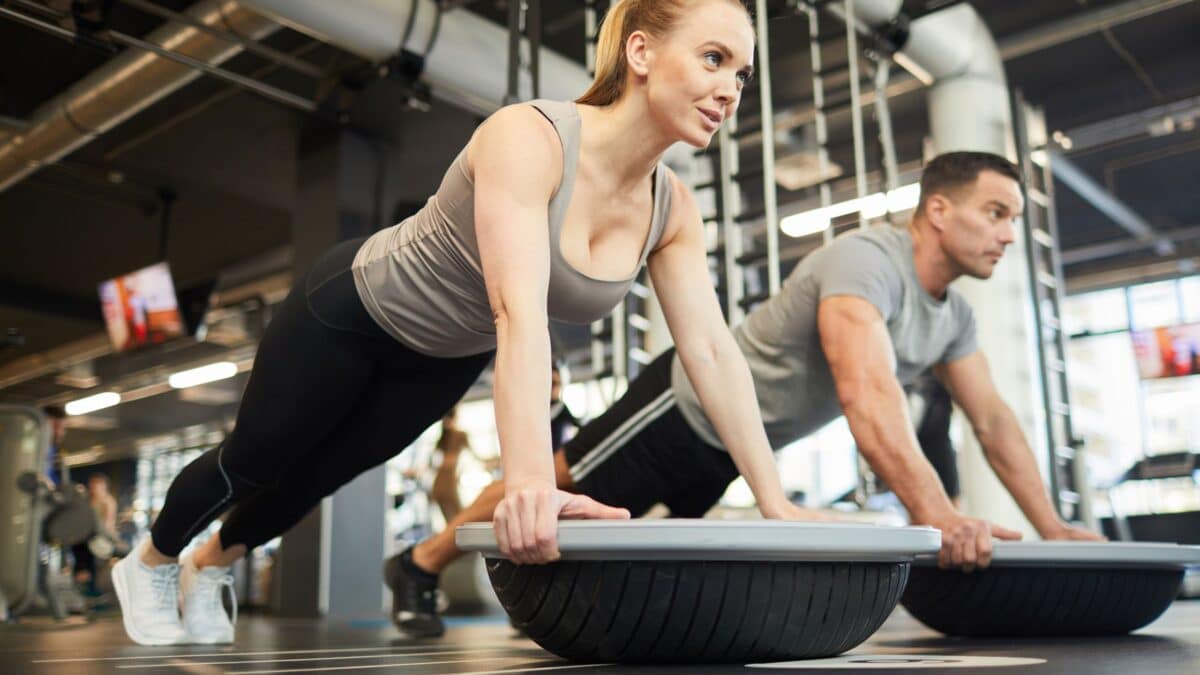
Vous pouvez rendre cet exercice dynamique en allant toucher des repères devant vous avec l’une de vos mains. Pensez à travailler les deux bras. 💦
Exercice 3 :
Il s’agit d’un nouvel exercice de gainage.
Sauf que cette fois, vos mains ou vos avant-bras, selon que vous ayez les bras tendus ou non, devront être placés sur un support instable (un BOSU ou une planche d’équilibre, par exemple).
Quand faire de la proprioception ?
Le travail proprioceptif peut être porteur de bienfaits à différents moments de la vie d’un athlète :
- Lors d’une préparation physique, pour préparer le corps à l’intensité d’une compétition sportive.
- À la suite d’une blessure, lors de la phase de réathlétisation (sous la supervision d’un kinésithérapeute).
- En continu, tout au long de l’année, pour renforcer ses articulations et prévenir d’éventuels traumatismes.
Il suffit d’intégrer quelques exercices simples dans votre programme d’entraînement, que ce soit au début de la séance de sport, ou à la fin. Vous pouvez même effectuer quelques mouvements peu exigeants en termes d’énergie entre vos exercices de musculation, sur vos temps de récupération.
Une autre option est de prévoir une dizaine de minutes par jour, au réveil par exemple, pour réaliser votre routine. ⏰
Conclusion
Vous savez maintenant comment travailler la proprioception. Grâce à ces 8 exercices simples, vous avez désormais toutes les cartes en main pour renforcer vos articulations et vos muscles posturaux. Il ne vous reste qu’à les inclure dans votre programme de musculation, ou lors de vos jours de repos. 💪
FAQ
La proprioception est la capacité du corps à percevoir sa position et ses mouvements dans l’espace sans avoir besoin de regarder.
Travailler la proprioception améliore l’équilibre, la coordination et la stabilité, tout en réduisant le risque de blessures.
Des exercices comme l’équilibre sur une jambe, les squats sur BOSU et le gainage instable sont efficaces.
Oui, il est possible de s’entraîner au poids du corps, par exemple en fermant les yeux ou en utilisant un sol instable.
Quelques minutes par jour ou plusieurs fois par semaine suffisent pour progresser et renforcer ses articulations. Elle peut être pratiquée en échauffement, en fin de séance ou pendant la récupération entre les exercices.
Oui, elle est essentielle en rééducation pour retrouver force, stabilité et prévenir les récidives.
Notes et références
- Rivera MJ, Winkelmann ZK, Powden CJ, Games KE. Proprioceptive Training for the Prevention of Ankle Sprains: An Evidence-Based Review. J Athl Train. 2017 Nov;52(11):1065-1067. doi: 10.4085/1062-6050-52.11.16. Epub 2017 Nov 15. PMID: 29140127; PMCID: PMC5737043. ↩︎
- Verhagen E, van der Beek A, Twisk J, Bouter L, Bahr R, van Mechelen W. The effect of a proprioceptive balance board training program for the prevention of ankle sprains: a prospective controlled trial. Am J Sports Med. 2004 Sep;32(6):1385-93. doi: 10.1177/0363546503262177. Epub 2004 Jul 20. PMID: 15310562. ↩︎
- Riva D, Bianchi R, Rocca F, Mamo C. Proprioceptive Training and Injury Prevention in a Professional Men’s Basketball Team: A Six-Year Prospective Study. J Strength Cond Res. 2016 Feb;30(2):461-75. doi: 10.1519/JSC.0000000000001097. PMID: 26203850; PMCID: PMC4750505. ↩︎




